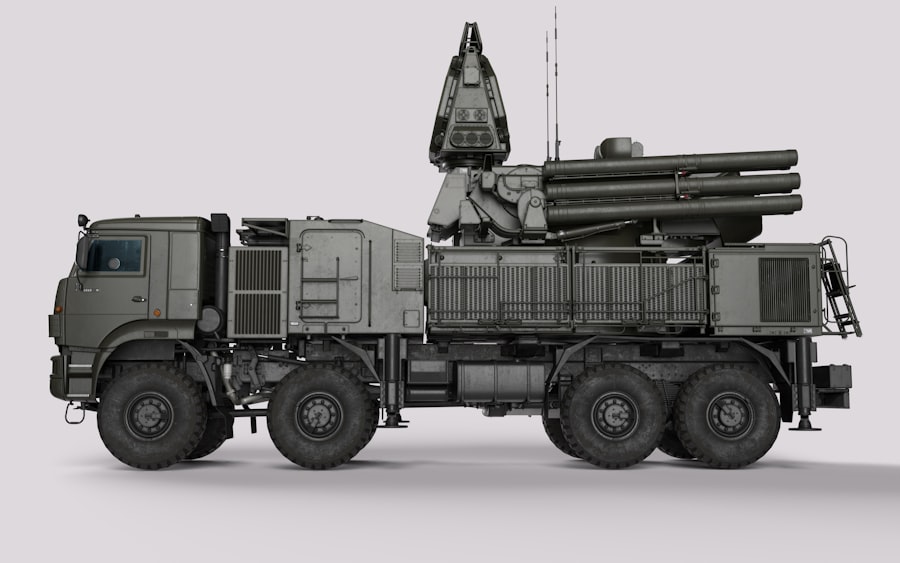Self-launching nuclear missiles represent a significant evolution in military technology, designed to enhance a nation’s deterrent capabilities. These systems are engineered to operate autonomously, allowing them to be deployed without direct human intervention. This capability is particularly crucial in scenarios where rapid response is necessary, such as during an imminent threat or a surprise attack.
The concept of self-launching missiles raises numerous questions about control, reliability, and the potential for unintended consequences. The fundamental principle behind self-launching nuclear missiles lies in their ability to assess threats and make decisions based on pre-programmed criteria. This autonomy is achieved through advanced algorithms and artificial intelligence, which enable the missile systems to evaluate incoming data and determine the appropriate course of action.
As nations continue to develop these technologies, understanding their operational frameworks becomes essential for comprehending their implications on global security.
Key Takeaways
- Self-launching nuclear missiles are capable of being launched without human intervention, using automated systems and artificial intelligence.
- The technology behind self-launching nuclear missiles involves advanced sensors, communication systems, and decision-making algorithms to ensure accuracy and reliability.
- The advantages of self-launching nuclear missiles include faster response times, reduced vulnerability to enemy attacks, and the ability to operate in challenging environments.
- The challenges of self-launching nuclear missiles include the risk of accidental or unauthorized launch, potential malfunctions in automated systems, and the ethical implications of delegating such power to machines.
- The strategic implications of self-launching nuclear missiles are significant, as they can impact deterrence strategies, crisis stability, and the balance of power in international relations.
The Technology Behind Self-Launching Nuclear Missiles
The technology that underpins self-launching nuclear missiles is a complex amalgamation of various fields, including computer science, engineering, and military strategy. At the heart of these systems are sophisticated sensors and communication networks that allow for real-time data processing. These components work in tandem to ensure that the missile can accurately identify targets and execute launch protocols without human oversight.
Artificial intelligence plays a pivotal role in the functionality of self-launching nuclear missiles. Machine learning algorithms are employed to analyze vast amounts of data, enabling the system to distinguish between genuine threats and false alarms. This capability is crucial in preventing accidental launches, which could have catastrophic consequences.
The Advantages of Self-Launching Nuclear Missiles

One of the primary advantages of self-launching nuclear missiles is their ability to provide a rapid response to threats. In a world where time is often of the essence, these systems can react almost instantaneously to incoming attacks, potentially neutralizing threats before they escalate. This speed can serve as a powerful deterrent against adversaries who may consider launching an attack, knowing that their actions could provoke an immediate and devastating response.
Moreover, self-launching nuclear missiles can reduce the burden on military personnel. By automating certain aspects of missile deployment, these systems can free up human resources for other critical tasks within the military framework. This efficiency not only enhances operational readiness but also allows for a more streamlined command structure.
As nations invest in these technologies, they may find themselves better equipped to handle complex military scenarios with fewer personnel.
The Challenges of Self-Launching Nuclear Missiles
Despite their advantages, self-launching nuclear missiles are not without significant challenges. One of the most pressing concerns is the risk of accidental launches due to technical malfunctions or misinterpretations of data. The reliance on artificial intelligence raises questions about the reliability of decision-making processes that lack human oversight.
A malfunction in the system could lead to catastrophic consequences, making it imperative for nations to implement rigorous testing and validation protocols. Additionally, there are ethical considerations surrounding the use of autonomous weapons systems. The delegation of life-and-death decisions to machines poses moral dilemmas that society must grapple with.
Questions arise about accountability in the event of an unintended launch or a failure to act when necessary. As nations navigate these challenges, they must balance technological advancements with ethical responsibilities to ensure that self-launching nuclear missiles do not exacerbate global tensions.
The Strategic Implications of Self-Launching Nuclear Missiles
The strategic implications of self-launching nuclear missiles extend far beyond individual nations; they have the potential to reshape global power dynamics. As countries develop these capabilities, they may feel emboldened to adopt more aggressive postures in international relations. The presence of autonomous nuclear systems could lead to an arms race, as nations strive to match or surpass each other’s technological advancements.
Furthermore, the introduction of self-launching nuclear missiles complicates existing deterrence strategies. Traditional deterrence relies on the threat of retaliation; however, with autonomous systems in play, the calculus changes significantly. Adversaries may find it challenging to predict responses, leading to increased uncertainty and instability in international relations.
This unpredictability could heighten tensions and create an environment ripe for conflict.
The Role of Self-Launching Nuclear Missiles in Modern Warfare

In modern warfare, self-launching nuclear missiles are poised to play a critical role in shaping military strategies. Their ability to operate independently allows for more flexible and dynamic responses to threats on the battlefield. As conflicts become increasingly complex and multifaceted, these systems can provide commanders with options that were previously unavailable.
Moreover, self-launching nuclear missiles can serve as a force multiplier in asymmetric warfare scenarios. Nations with limited conventional military capabilities may rely on these advanced systems to deter larger adversaries. The mere existence of such technology can alter the strategic landscape, compelling opponents to reconsider their military strategies and alliances.
As a result, self-launching nuclear missiles may become integral components of national defense strategies in an era characterized by rapid technological advancements.
The Ethics and Morality of Self-Launching Nuclear Missiles
The ethical implications surrounding self-launching nuclear missiles are profound and multifaceted. The delegation of lethal decision-making authority to machines raises significant moral questions about accountability and responsibility. In scenarios where an autonomous system misinterprets data and launches a missile erroneously, determining culpability becomes exceedingly complex.
This ambiguity challenges traditional notions of warfare ethics and complicates discussions about just war theory. Furthermore, there is a broader societal concern regarding the normalization of autonomous weapons systems in military operations. As nations increasingly rely on technology for warfare, there is a risk that society may become desensitized to the consequences of violence.
The potential for machines to make life-and-death decisions could lead to a diminished sense of moral responsibility among military leaders and policymakers. Engaging in open dialogues about these ethical dilemmas is essential for ensuring that technological advancements align with humanity’s moral compass.
The International Response to Self-Launching Nuclear Missiles
The international community’s response to self-launching nuclear missiles has been varied and complex. Some nations view these systems as essential components of their national security strategies, while others express deep concerns about their proliferation and potential misuse. Diplomatic efforts aimed at regulating autonomous weapons have gained traction in recent years, with discussions focusing on establishing norms and frameworks for their development and deployment.
International treaties and agreements play a crucial role in shaping the discourse surrounding self-launching nuclear missiles. Efforts such as the Treaty on the Non-Proliferation of Nuclear Weapons (NPT) seek to prevent the spread of nuclear weapons technology while promoting disarmament initiatives. However, as new technologies emerge, existing frameworks may need to be reevaluated to address the unique challenges posed by autonomous systems effectively.
The Future of Self-Launching Nuclear Missiles
Looking ahead, the future of self-launching nuclear missiles is likely to be characterized by rapid technological advancements and evolving geopolitical landscapes. As nations continue to invest in research and development, it is anticipated that these systems will become more sophisticated and capable over time. This evolution may lead to new operational paradigms within military strategies as countries adapt to the changing nature of warfare.
However, this future also raises critical questions about governance and regulation. As self-launching nuclear missiles become more prevalent, establishing international norms and agreements will be essential for mitigating risks associated with their use. Collaborative efforts among nations will be necessary to ensure that technological advancements do not outpace ethical considerations or regulatory frameworks.
The Potential Risks and Consequences of Self-Launching Nuclear Missiles
The potential risks associated with self-launching nuclear missiles are significant and warrant careful consideration. One major concern is the possibility of escalation due to miscommunication or misinterpretation of data by autonomous systems. In high-stakes situations where time is limited, a miscalculation could lead to unintended consequences that spiral out of control.
Additionally, there is a risk that adversaries may perceive self-launching nuclear missiles as a threat, prompting preemptive strikes or aggressive posturing in response. This dynamic could create a cycle of tension and conflict that undermines global stability. As nations navigate these risks, it becomes imperative to prioritize dialogue and diplomacy as tools for conflict resolution.
The Importance of Safeguards and Regulations for Self-Launching Nuclear Missiles
Given the complexities surrounding self-launching nuclear missiles, implementing robust safeguards and regulations is paramount for ensuring global security. Establishing clear protocols for testing, deployment, and operational oversight can help mitigate risks associated with autonomous systems. Additionally, fostering transparency among nations regarding their capabilities can build trust and reduce misunderstandings.
International cooperation will be essential in developing comprehensive regulatory frameworks that address the unique challenges posed by self-launching nuclear missiles. Collaborative efforts can facilitate information sharing and promote best practices among nations while ensuring that ethical considerations remain at the forefront of technological advancements in military applications. By prioritizing safeguards and regulations, the international community can work towards a future where self-launching nuclear missiles contribute positively to global security rather than exacerbate existing tensions.
In recent discussions about the advancements in military technology, the concept of self-launching nuclear missiles has garnered significant attention. These autonomous weapons systems are designed to operate with minimal human intervention, raising both strategic advantages and ethical concerns. For those interested in exploring more about the implications and technological underpinnings of such innovations, a related article can be found on HeyDidYouKnowThis. This article delves into the broader context of autonomous military technologies and their potential impact on global security. You can read more about it by visiting this link.
WATCH THIS! The Nuclear Doomsday Machine Russia Built That Runs Itself
FAQs
What are self-launching nuclear missiles?
Self-launching nuclear missiles are missiles equipped with the capability to launch without human intervention. This means they can be programmed to launch automatically in response to certain conditions or triggers, such as a detected incoming nuclear attack.
How do self-launching nuclear missiles work?
Self-launching nuclear missiles are equipped with advanced computer systems and sensors that can detect and analyze potential threats. When a threat is detected, the missile’s system can automatically initiate the launch sequence without the need for human input.
What are the potential risks of self-launching nuclear missiles?
The main risk of self-launching nuclear missiles is the potential for accidental or unauthorized launches. Malfunctions in the missile’s detection systems or hacking of the missile’s control systems could lead to unintended launches, potentially sparking a nuclear conflict.
Are there any safeguards in place for self-launching nuclear missiles?
There are strict protocols and safeguards in place to prevent accidental or unauthorized launches of self-launching nuclear missiles. These may include multiple layers of authentication and authorization, as well as fail-safes to prevent false alarms from triggering a launch.
What are the benefits of self-launching nuclear missiles?
Proponents of self-launching nuclear missiles argue that they can provide a faster and more reliable response to incoming nuclear threats, potentially increasing the effectiveness of a country’s nuclear deterrent. Additionally, they may reduce the risk of human error in the decision-making process.
